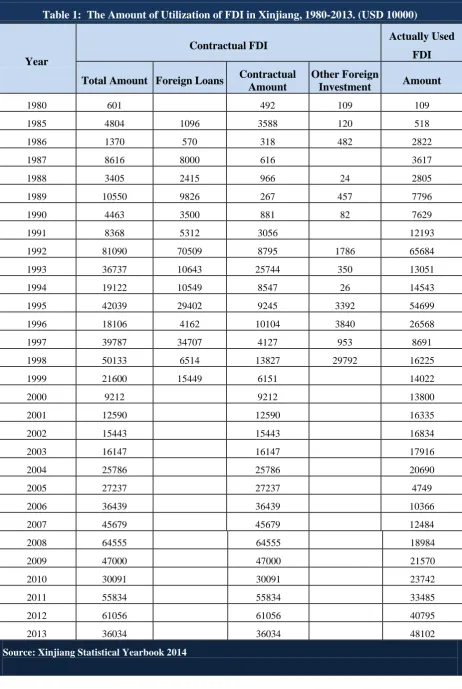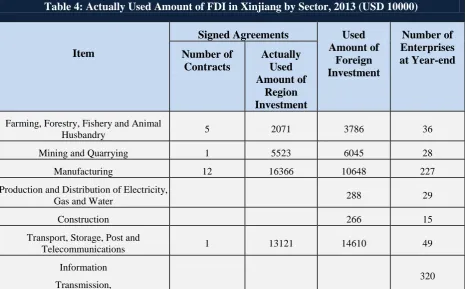SCITECH
Volume 5, Issue 4
RESEARCH ORGANISATION
March 8, 2016
Journal of Research in Business, Economics and Management
www.scitecresearch.com
Research on the Utilization of Foreign Direct Investment in
Xinjiang Uygur Autonomous Region of China
CAI Li, ZHANG Xiaowei
International Business School, Dalian Nationalities University, Dalian, China.
Abstract
With the implement of economic reform and opening-up policy over 30 years, the utilization of foreign direct investment (FDI) in Xinjiang has been developing fast. FDI increased obviously in scale with great achievements of outstanding effects, however, there are still some problems in the utilization of FDI in Xinjiang. The paper summarizes the basic situation about using FDI in Xinjiang and proposes strategies and suggestions to optimize using FDI, extend the source of FDI, improve the scale and quality of foreign investment with perfect supporting system of Xinjiang government.
Keywords:
Foreign Direct Investment; FDI; Xinjiang; China.1.
The Situation of Utilizing FDI in Xinjiang
1.1 Utilization of FDI by Scale
Table 1: The Amount of Utilization of FDI in Xinjiang, 1980-2013. (USD 10000)
Year
Contractual FDI
Actually Used
FDI
Total Amount Foreign Loans
Contractual
Amount
Other Foreign
Investment
Amount
1980 601 492 109 109
1985 4804 1096 3588 120 518
1986 1370 570 318 482 2822
1987 8616 8000 616 3617
1988 3405 2415 966 24 2805
1989 10550 9826 267 457 7796
1990 4463 3500 881 82 7629
1991 8368 5312 3056 12193
1992 81090 70509 8795 1786 65684 1993 36737 10643 25744 350 13051 1994 19122 10549 8547 26 14543 1995 42039 29402 9245 3392 54699 1996 18106 4162 10104 3840 26568 1997 39787 34707 4127 953 8691 1998 50133 6514 13827 29792 16225
1999 21600 15449 6151 14022
2000 9212 9212 13800
2001 12590 12590 16335
2002 15443 15443 16834
2003 16147 16147 17916
2004 25786 25786 20690
2005 27237 27237 4749
2006 36439 36439 10366
2007 45679 45679 12484
2008 64555 64555 18984
2009 47000 47000 21570
2010 30091 30091 23742
2011 55834 55834 33485
2012 61056 61056 40795
2013 36034 36034 48102
In term of foreign investment in Xinjiang by region, the actual FDI from Hong Kong is at the top. A series of favorable policies was introduced by Chinese government to encourage and support the foreign direct investment. The contractual foreign direct investment is led by Singapore, but the actual investment volume is far less than that of Hong Kong, from which we can also find that Hong Kong is optimistic about the development of Xinjiang.
Table 2: Utilization of FDI in Xinjiang by Country or Territory, 2013 (USD 10000)
Item
Signed Agreements
Used Amount
of Foreign
Investment
Number of
Enterprises at
Year-end
Number of
Contracts
Actually Used
Amount of
Region
Investment
Hong Kong, China 7 3382 26645 195
Taiwan, China -362 189 21
Japan 181 10
America 1 9 376 26
Canada 1 8 8
Germany 167 5
Turkey 3 16 83
UK 2 65 106 6
Singapore 1 4550 903
Australia 245 11 13
The Commonwealth of the
Independent States 18 890 378 26
Malaysia 1 997
Republic of Korea 1 -244 11 22
Source: Xinjiang Statistical Yearbook 2014
1.3 Utilization of FDI by Form
Table 3: Utilization of FDI in Xinjiang by Form, 2012-2013. (USD 10000)
Item
2012
2013
Number
of Project
Contractual
Value
Used
Value
Number
of
Project
Contractual
Value
Used
Value
Total 55 61056 40795 42 36034 48102 Foreign Investment
Enterprises 32 22841 13536 30 2941 26446 Joint Venture Enterprises 22 23419 12413 12 12094 12221
Cooperative Operation
Enterprises 1 2734 13 7340 109 Share-holding Corporations Ltd. 12062 14833 13659 9326
Source: Xinjiang Statistical Yearbook 2014
1.4 Utilization of FDI by Industry
At the beginning of reform and opening-up, foreign invested industries were limited to manufacturing and services sectors. After the development of 20 years, FDI has covered agriculture, construction, transportation, post and telecommunications, wholesale and retail trade, real estate, public utilities, resident service and other sectors. Mining industry and manufacturing account the largest proportion of FDI due to the predominant geological location and unique excellent resource conditions of Xinjiang. In the past few years, wholesale and retail trade, manufacturing and mining industry have been developing fast, but the development of secondary industry and the lag of the tertiary industry of Xinjiang led to the unbalanced development of using FDI in Xinjiang.
Table 4: Actually Used Amount of FDI in Xinjiang by Sector, 2013 (USD 10000)
Item
Signed Agreements
Used
Amount of
Foreign
Investment
Number of
Enterprises
at Year-end
Number of
Contracts
Actually
Used
Amount of
Region
Investment
Farming, Forestry, Fishery and Animal
Husbandry 5 2071 3786 36
Mining and Quarrying 1 5523 6045 28 Manufacturing 12 16366 10648 227 Production and Distribution of Electricity,
Gas and Water 288 29
Construction 266 15
Transport, Storage, Post and
Telecommunications 1 13121 14610 49 Information
Computer Services and Software Industry Wholesale and Retail
Trade 22 13593 2644 360
Accommodation and Catering Service
3 9 10 67
Financial Intermediation 1 1112 33
Real Estate 257 19
Leasing and Business
Services 8 9067 1572 67
Scientific Research, Technical Services
and Geological Prospecting 2 162 620 29 Water Conservancy, Environment and
Public Facility Management 6 Service to Households and Other Services
Industries 32 49 20
Education 2
Culture, Sports and Entertainment 3
Source: Xinjiang Statistical Yearbook 2014
1.5 Utilization of FDI by Region
Cities that developed fast in utilizing FDI among 13 cities of Xinjiang in 2014 are Shihezi City, Aksu Administrative Offices, Bayangol Mongol Autonomous Prefecture, the growth rates were respectively 62.1%, 14.15% and 9.6%. Among 13 cities in Xinjiang, the first five cities of using FDI were respectively: Urumqi City (USD 177.92 million), Shihezi City (USD 34.04 million); Changji Hui Autonomous Perfecture (USD 44.77 million); Ili Kazak Autonomous Prefecture (USD 36.16 million); Aksu Administrative Offices (USD 34.04 million). The amount of above top five cities was USD 409.24 million which accounted for 85% of the amount of actually used FDI in Xinjiang of that year.
Table 5
:
Actually Used Amount of FDI in Xinjiang by Region, 2012-2013 (USD 10000)
Region
2012
2013
Number of
Contracts
Contract
Value
Amount of
Foreign
Capital
Actually
Used
Number of
Contracts
Contract
Value
Amount of
Foreign
Capital
Actually
Used
Total 55 61056 40795 42 36035 48102 Urumqi City 35 24166 17572 25 20015 17792
Karamay City 1 52 1720 -5 1741
Shihezi City
Turpan Administrative
Offices 1 545 300 1 8 345
Kumul Administrative
Offices 583 2333 2877 1648 Changji Hui Autonomous
Perfecture 4 7850 4174 3 5905 4477 Ili Kazak Autonomous
Prefecture 3 2525 3819 3 2830 3616 Bortala Mongol
Autonomous Prefecture 1 2393 20 Bayangol Mongol
Autonomous Prefecture 2 4784 2858 2 -289 3160 Aksu Administrative
Offices 2 1273 2922 3 4332 3404 Kizilsu Kirghiz
Autonomous Prefecture 2323 11 Kashgar Administrative
Offices 1 169 680 2 712 284
Hotan Administrative
Offices
Source: Xinjiang Statistical Yearbook 2014
2.
Recommended Policy for Improving the Utilization of FDI in Xinjiang
2.1 Optimizing the Structure of Utilization of FDI
Firstly, Xinjiang should promote textile and clothing industry with the help from textile and clothing enterprises from Eastern China and Southern China, including Zhejiang provinces, Shanghai, Anhui provinces, to investigate for investment in Xinjiang to promote the development of textile and clothing industry with high starting point, high level and high efficiency. Secondly, Xinjiang should introduce engineering machinery, wind power equipment, rail transportation equipment, new energy equipment from the high-quality enterprises that own intellectual property rights to Xinjiang. Thirdly, new energy, new materials, bio-pharmaceuticals and energy conservation are all new starting points of inviting investment recently. At the same time, information technique and electronic business are developing fast in Xinjiang. Forth, Xinjiang should promote the development of agriculture processing and light industry and support the development of handicraft industries with national features in Southern Xinjiang. Fifth, Xinjiang should introduce silk road industrial projects and construct silk road economic belt and transfer some industries faced to middle Asia and Europe as to bring new opportunities and take good advantages of differentiate industry strategy and low prices of electricity to create perfect investment environment. Xinjiang should improve the cooperation of industries and guide the enterprises especially the inland Chinese enterprises to establish high-tech industrial park and logistics center, and introduce inland Chinese enterprises to take advantage of Xinjiang priorities to develop import and export processing projects that faced to neighboring markets. Xinjiang need introduce modern service enterprises, devote more effort to transform and improve traditional service industry, promote productive services, develop industries that attract foreign investment, and construct energetic, sociable modern service system. Xinjiang need actively promote the healthy development of real estate market to increase investment of real estate, and develop traveling new products, new routes to promote the tourism for further development.
2.2 Improving Service Supporting System of Government
problems and solving problems of the difficulties of promoting the FDI project, and ensure the implement of significant FDI projects especially focusing on the following important events: the Asia and Europe Expo, the Investment &Trade Forum for Cooperation Between East &West of China, the Western China International Economy and Trade Fair and etc.
Xinjiang should actively create perfect investment environment and organize all kinds of inviting investment introduction and promoting activities according to different features of industries, unify the local private enterprises tightly through various platforms, form encouraging mechanism and social atmosphere that are strongly supported by government.
Acknowledgement
This research is supported by the Fundamental Research Funds for the Central Universities of China (20150429).
References
[1] Xinjiang Provincial Bureau of Statistics, (2014) Xinjiang Statistical Yearbook, (pp. 124-127). Beijing: China Statistics Press, (Chapter 5)



